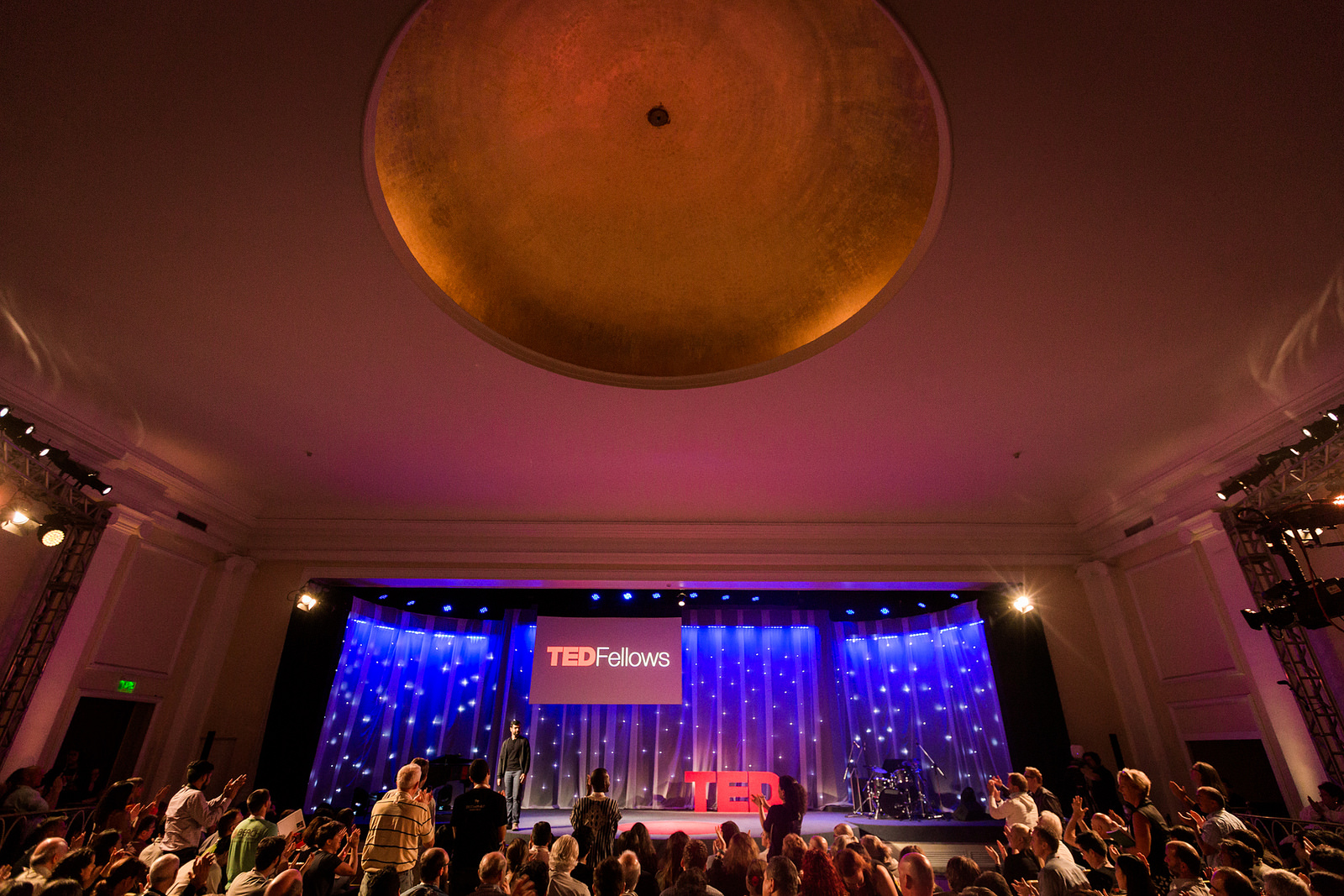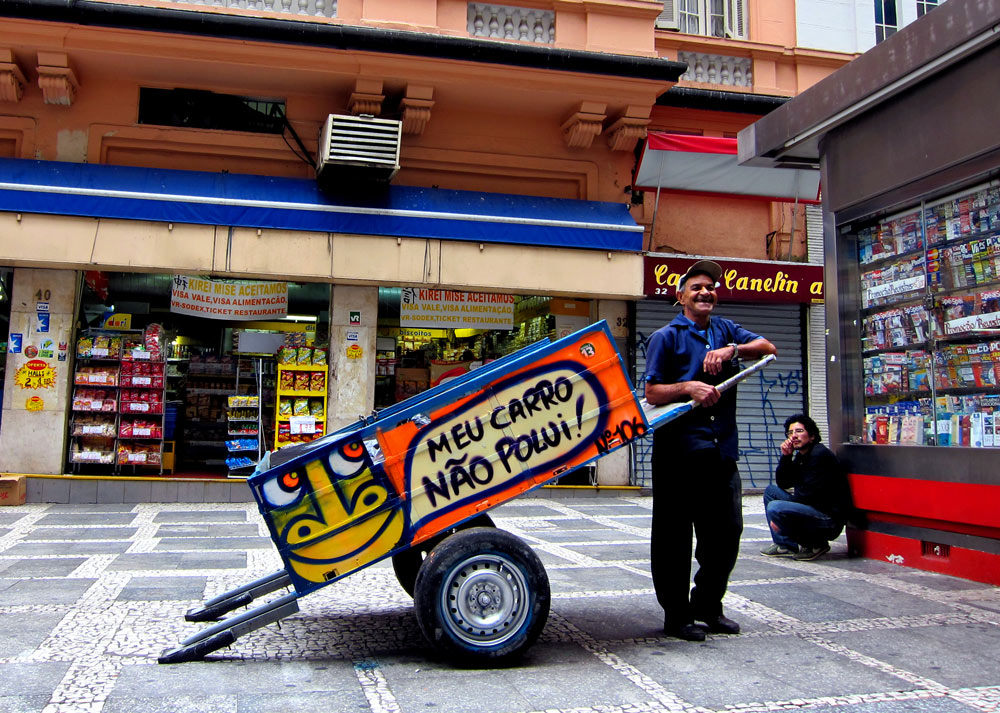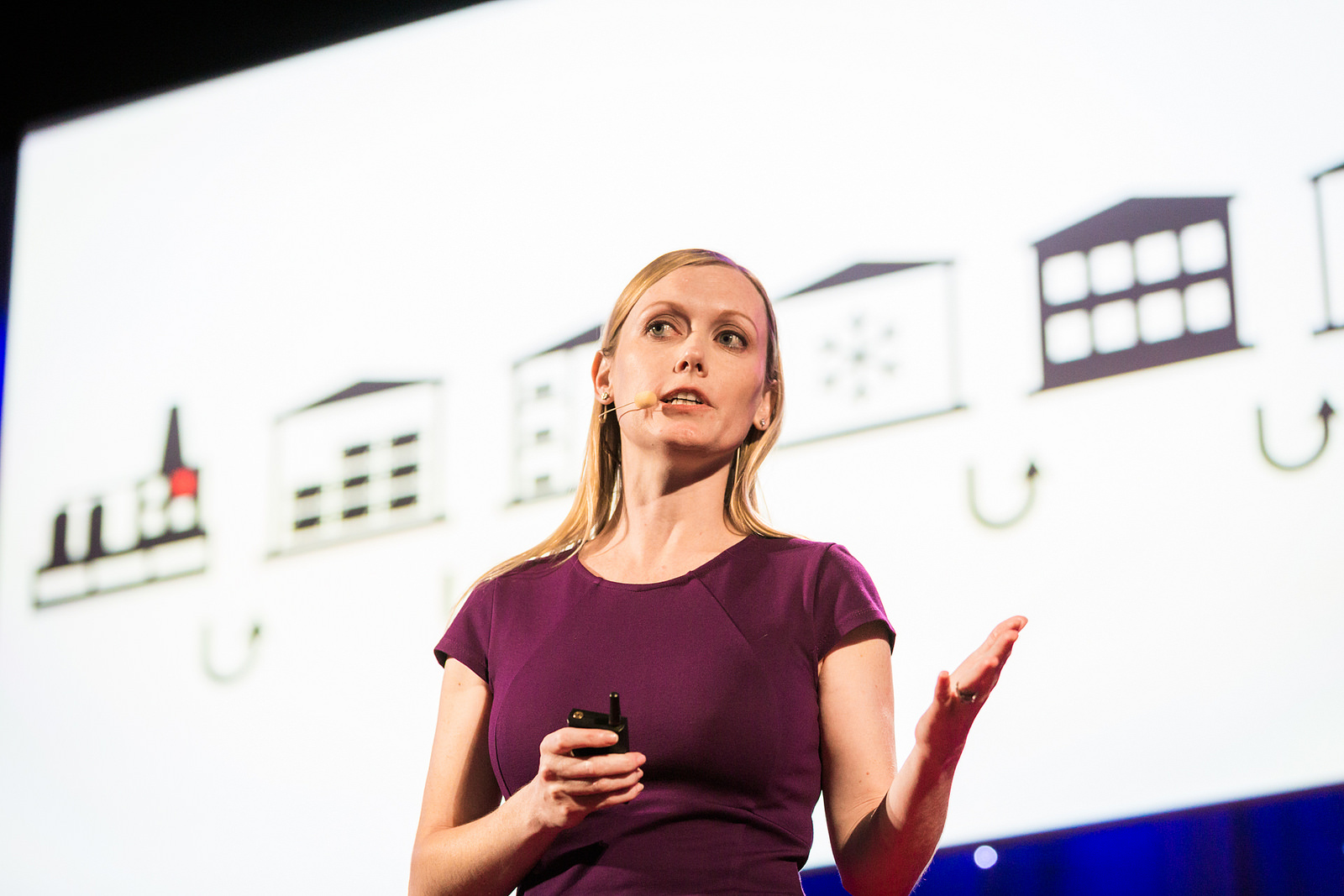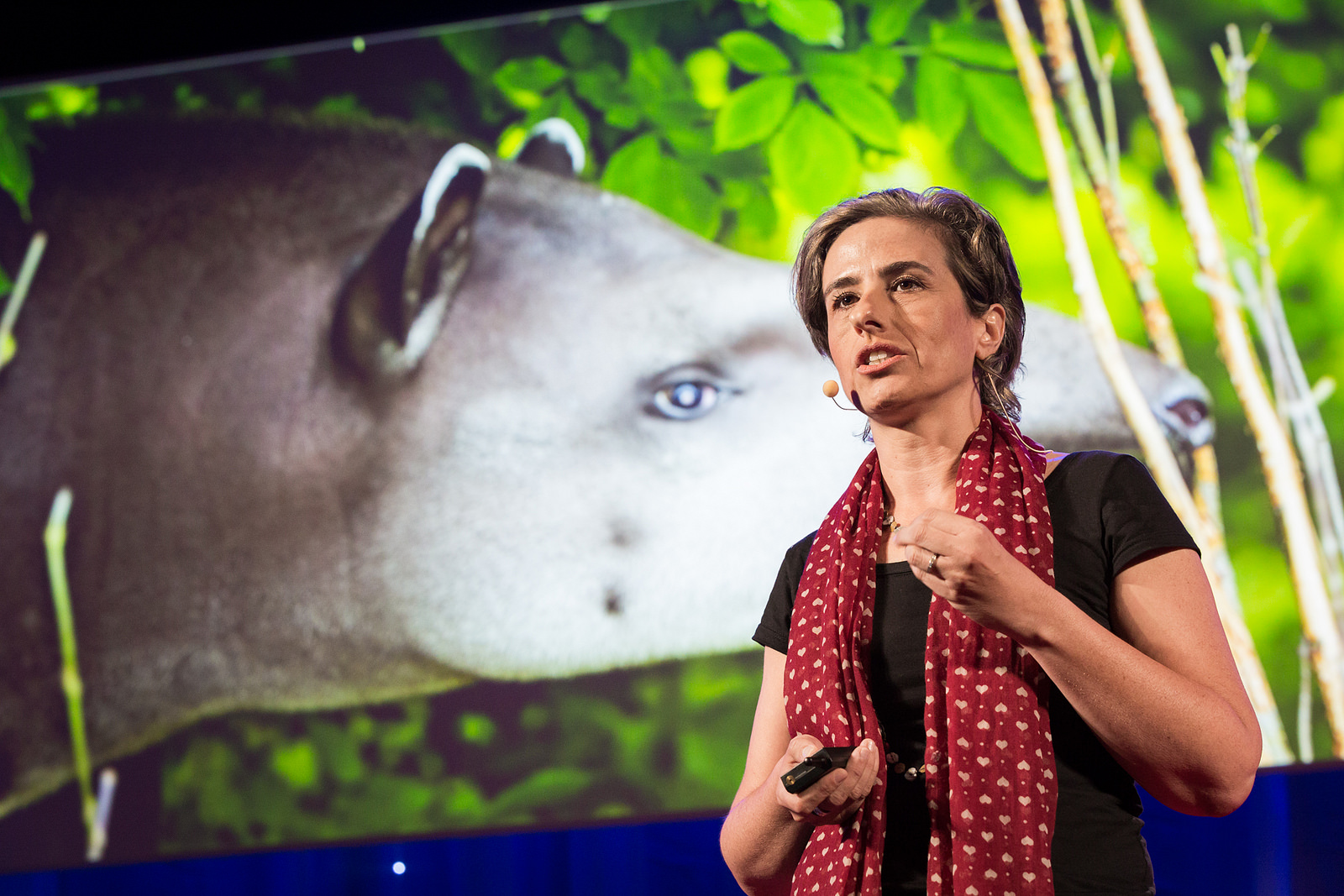
The TED Fellows gave a lively session of talks at TEDGlobal. Midway through, filmmaker and butcher Bassim Tariq gets a standing ovation. Photo: Ryan Lash
It’s time for TED Fellows Talks, the Rio edition! Twenty TED Fellows and Senior Fellows opened the conference in the stunning Golden Room of the Copacabana Palace Hotel. In Session 1, learn more about a grassroots marine conservation movement in Madagascar, a vending machine that dispenses food staples in Chile and a new database of African genetics. Plus much, much more.
Pakistani composer Usman Riaz opens the Fellows session with his new piano piece, “The Creation of the Universe.” It starts out quiet and dreamy, opening out into a dramatic second movement. The multitalented Riaz is also a filmmaker and visual artist, and a sophomore at the Berklee College of Music.
Kuwaiti-born Palestinian photographer Laura Boushnak faced many barriers on her way to becoming a photographer. This inspired her to turn her lens on women in the Arab world who are also motivated to improve their lives through education, while confronting cultural and social barriers. In her project “I Read, I Write,” Boushnak addresses such topics as female illiteracy — which is quite high in the region — as well as educational reforms and political activism among university students. Often, her subjects — who hail from a wide range of social and economic situations — are reluctant to be photographed, but agree once Boushnak reassures them that they will serve as role models in their communities. Sometimes, Boushnak asks women to write their thoughts on prints of their portraits. She shares some of their words. “I sought education in order to be independent and not count on men for everything,” writes Aisha, a teacher from Yemen. And, from a Tunisian activist: “Question your convictions, be who you want to be, not who they want you to be; don’t accept their enslavement, for your mother birthed you free.”
Marine ecologist Alasdair Harris has a new metaphor for fish conservation: investment banking. When a few fish are allowed to reproduce in reserves, their fertility explodes. The bigger they grow, the more they produce, eventually swimming out of the reserve to replenish nearby oceans where people fish for food. With the simple and effective idea of marine reserves, says Harris, humanity could rebuild the world’s fish stocks — if we could manage to put a third of our oceans in reserve. This is a problem because, at the moment, only a small single-digit percentage of our oceans are protected, and it’s also hard to persuade people whose livelihoods depend on fishing to stop, especially where stocks are already low. Working with octopus fishers in Madagascan villages, Harris convinced one community to stop fishing in a portion of reef to allow local octopi to recover. People saw their long-depleted stocks come back, and watched the octopi grow to ten times their normal size. With this, villagers saw that they could rebuild their fisheries themselves, and the idea went viral. Now Madagascan fishing villages have created 63 permanent reserves in eight years — a fast-growing, locally driven conservation solution working for a quarter of a million Madagascans.
“Our world has many supherheroes,” says Brazilian graffiti artist and activist Mundano, “but they have the worst of all superpowers: invisibility.” He’s referring to catadores, Brazil’s waste pickers, who do the essential work of collecting recyclable materials for a living, pushing carts called carroças to haul materials away. In Brazil, catadores collect 90% of the waste that is recycled. To celebrate these unsung heroes, Mudano began decorating carroças with graffiti art, using color and humor to increase their visibility and stature in the streets, society and culture. He then created Pimp My Carroça, a crowdfunded event that invites everyone from physicians, podiatrists, hairstylists and massage therapists to offer services to catadores, while artists paint their carts with vivid graffiti and outfit them with reflective tape, horns and mirrors. The demand for this event grew to other cities, even outside Brazil, spawning an offshoot independent event, Pimpex — DIY events inspired by TEDx. To date, Mundano has painted more than 200 carroças, and has visited wastepicking cultures in Argentina, Chile, Bolivia, South Africa, Turkey, the US and Japan. There are over 20 million catadores worldwide, Mudnano notes, and he challenges us to see them as a vital part of our society.

A catadore shows off his pimped carroça, created by TED Fellow and street artist Mundano. Photo: Courtesy of Mundano
The Save the Whales campaigns of the 1970s managed to stop commercial whaling, says Sri Lankan marine biologist Asha de Vos, but whales are still very low in numbers and facing a range of human-induced threats. It’s time to think again about why whales are so valuable to humanity. And as de Vos suggests: Whales are ecosystem engineers, critical to maintaining the health and stability of oceans, which in turn provides critical services to human beings. First, whales poop — as they dive to feed and resurface to breathe, they create enormous fecal plumes that feed the phytoplankton that form the basis of the entire marine food chain. Whales also transport these nutrients horizontally through the oceans when they migrate. And after death, whale carcasses fall to the bottom of the sea, feeding 400-odd species and acting as carbon sinks that delay global warming. So let’s save the whales again, she says — not just for their sake, but for ours.
Photojournalist and activist Boniface Mwangi tells the story of his journey from witness to activist. Having documented the post-election inter-tribal violence of 2007 as a photographer for a Kenyan newspaper, Mwangi was dismayed when politicians and the country quickly recovered and carried on as though nothing had happened. The victims — more than 1,000 dead — were forgotten. Disturbed, Mwangi quit his job and began organizing an action with friends to speak out against the violence and corruption. But when he turned up at the stadium to confront the president, he found himself alone. All his friends had bowed out. In that moment, Mwangi had to decide what to do: stay quiet, or stand up alone and shout. Choosing the latter was an act that got him beaten and arrested. It was a point of no return: Mwangi soon grew more innovative in his activism, holding street exhibitions of the photos he’d taken during the violence. He did political graffiti and mock burials — even delivering blood-covered pigs to the Kenyan government to protest their greed. His work as an activist is now well known, and he works with a community of passionate and courageous activists. “I died in the stadium,” he concludes. “The two most powerful days in your life are the day you are born — and the day you discover why. Do you know why were you born?”
When Jose Manuel Moller moved as a student to a poor neighborhood in outskirts of Santiago, Chile, a few years ago, he found himself having to buy food staples from tiny local shops called almacenes. Everyday basics there came in small quantities, which is affordable on a daily basis but work out to cost much more than larger supermarket sizes in the long run. He calls this the “poverty tax”: low-income families are ultimately forced to pay more for less. This is something that happens in small groceries around the world. His solution: Algramo – a vending machine that dispenses bulk staples. His company fills the vending machines and installs them for free in almacenes, splitting profit 50/50 with shopkeepers, who can then compete with supermarkets. The shorter supply chain cuts out the excess packaging, labeling and middleman, and products cost 40% less than the packaged versions on shop shelves. Moller has installed 100 vending machines in Santiago in six months, reaching an estimated 12,000 people. Algramo will soon expand to Bogota, and he hopes to expand to all of Latin America within a decade.
One in five children in the developing world doesn’t get even basic vaccines, says South African neuroscientist Catharine Young, leading to 2 million needless deaths every year. But why? The answer lies in the long and complex supply chain. Obstacles vary by country, but in general, vaccines travel a long and complex route from manufacturer to health clinics, and handwritten records and lack of refrigeration pose a real problem along the way. Ultimately, 50% of vaccines never make it to the children they’re intended for. The answer, says Young, is to gather data to understand and improve each supply chain. She is developing an app that tracks not the vaccine but the driver, who can use it to monitor the journey of the vaccine. The data gathered will not only help expose the weak points in each supply chain, but also make records electronic and ensure the vaccines are taken on the shortest and most efficient routes. With the data collected, Young hopes to save 50% of the vaccines that are normally lost, saving both money and lives.

Catharine Young charts the long journey of a vaccine, which can often go to central, regional, provincial and district warehouses before it gets delivered. Photo: Ryan Lash
How does someone become a blogger, filmmaker — and butcher? Bassam Tariq tackles conventional perspectives of Muslim life in America and beyond, in wildly creative ways. In his blog project 30 Mosques in 30 Days, he and a friend took a month-long road trip through the United States, breaking their Ramadan fast in mosques in 30 states, and documenting the vastly diverse Muslim-American communities they encountered on the way — from a Cambodian refugee enclave in California to Black Sufis in the woods of South Carolina. Later, while making his film These Birds Walk — about wayward kids seeking love and family in Pakistan — his peers urged him to include target killings and political corruption to make it more “relevant.” But Tariq insisted on anchoring the story in empathy, unusual for films from this region. Back in New York, worried about the integrity of the Halal meat he was buying, he opened a shop in the East Village, making high-quality Halal meat accessible to working-class families — 90 percent of whom aren’t even Muslim. “For many, it’s the first time people are interacting with Islam on intimate level,” says Tariq. What holds this all together? Tariq says it’s a response to those who continuously oversimplify his beliefs and communities, which deserve to be acknowledged and respected in uncompromising ways.
Did you know that in the United States, local police now have NSA-style surveillance equipment that allows police to amass vast quantities of private information about you? Attorney and privacy advocate Catherine Crump explains how the automatic license plate reader, a device mounted on patrol cars or highway infrastructure, allows police to capture photos of every passing plate, checking them against lists of wanted cars. Along with this data, police take photos of citizens going about their daily lives, giving them detailed information of where we are, when and with whom — even if we haven’t done anything wrong. Then there are cell tower dumps, which can reveal the location of tens of thousands of people near cell towers. And sting rays, which allow police to identify cell phones in people’s houses. Because of the plummeting cost of data storage, police departments can now keep location records indefinitely. Even more chillingly, the federal government is working to compile this information into vast databases. Crump questions the imbalance of power implied here, and calls for measures to correct it, noting that history shows that when government has vast quantities of private information, it’s vulnerable to abuse.
Right now, around 70% of all genetic data available is from Americans and Europeans, says Kenyan systems biologist Geoffrey Siwo. This means the remaining 30% is from 80% of the world’s population. This huge imbalance plays out in medicine and healthcare: while 71% of AIDs cases are in sub-Saharan Africa, for example, AIDs medicines are tested on Caucasian Americans. The problem is that genetic differences mean that medicines that are safe for Caucasian Americans may not work for Africans, who in turn also have substantial genetic differences across the continent. To help solve problems like this, Siwo wants Africans to have their own comprehensive genetic database, and is now creating one. He announces the United Genomes Project, which will gather genetic information from Africans in America, making it available to African scientists and students online for identifying safe medicines. He hope that they will use it for research and innovation. He envisions a future in which Africans own their own genetic data, develop their own drugs and chart their own destinies.
Conservationist Patricia Medici works with the South American lowland tapir, an eccentrically adorable animal that also happens to be the largest terrestrial mammal of South America. About half the size of a horse, the tapir is notable for its flexible snout with which it grabs food. Though not very well known, tapirs are actually very important to their ecosystems as an umbrella species, sharing a habitat with other species like peccaries, jaguars and pumas. “If you protect tapirs, you protect all these species,” says Medici. Called the “gardeners of the forest,” tapirs also help distribute the seeds of the foods they eat, playing a direct part in shaping and maintaining the structure of their habitat. Sadly, tapirs have a lowly reputation in Brazil (if you want to call someone a “jackass,” you call them a tapir), and they are threatened by deforestation, hunting and roads. And since tapirs reproduce very slowly, having only one offspring after a long gestation period, populations are extra vulnerable and slow to recover. “It is a fact,” says Medici, “that the extinction of tapirs would seriously impact biodiversity as a whole.”
And finally, Usman Riaz returns to the stage to perform one of his most popular songs, “Boneshaker” — a fast-moving and intricate piece, played in the percussive guitar style. Get a taste of this session-closing song here.

Meet the South American lowland tapir, an animal about half the size of a horse that deserves your deepest respect. Photo: Ryan Lash
Comments (4)